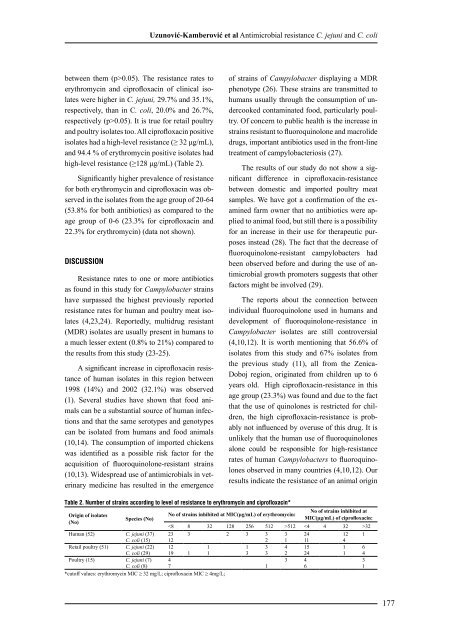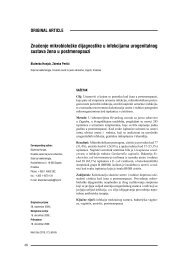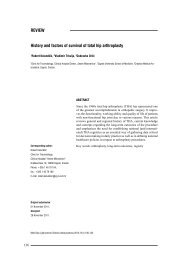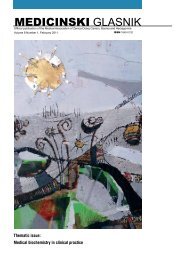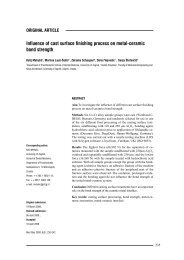MEDICINSKI GLASNIK
MEDICINSKI GLASNIK
MEDICINSKI GLASNIK
Create successful ePaper yourself
Turn your PDF publications into a flip-book with our unique Google optimized e-Paper software.
etween them (p>0.05). The resistance rates to<br />
erythromycin and ciprofloxacin of clinical isolates<br />
were higher in C. jejuni, 29.7% and 35.1%,<br />
respectively, than in C. coli, 20.0% and 26.7%,<br />
respectively (p>0.05). It is true for retail poultry<br />
and poultry isolates too. All ciprofloxacin positive<br />
isolates had a high-level resistance (≥ 32 μg/mL),<br />
and 94.4 % of erythromycin positive isolates had<br />
high-level resistance (≥128 μg/mL) (Table 2).<br />
Significantly higher prevalence of resistance<br />
for both erythromycin and ciprofloxacin was observed<br />
in the isolates from the age group of 20-64<br />
(53.8% for both antibiotics) as compared to the<br />
age group of 0-6 (23.3% for ciprofloxacin and<br />
22.3% for erythromycin) (data not shown).<br />
DISCUSSION<br />
Resistance rates to one or more antibiotics<br />
as found in this study for Campylobacter strains<br />
have surpassed the highest previously reported<br />
resistance rates for human and poultry meat isolates<br />
(4,23,24). Reportedly, multidrug resistant<br />
(MDR) isolates are usually present in humans to<br />
a much lesser extent (0.8% to 21%) compared to<br />
the results from this study (23-25).<br />
A significant increase in ciprofloxacin resistance<br />
of human isolates in this region between<br />
1998 (14%) and 2002 (32.1%) was observed<br />
(1). Several studies have shown that food animals<br />
can be a substantial source of human infections<br />
and that the same serotypes and genotypes<br />
can be isolated from humans and food animals<br />
(10,14). The consumption of imported chickens<br />
was identified as a possible risk factor for the<br />
acquisition of fluoroquinolone-resistant strains<br />
(10,13). Widespread use of antimicrobials in veterinary<br />
medicine has resulted in the emergence<br />
Table 2. Number of strains according to level of resistance to erythromycin and ciprofloxacin*<br />
Origin of isolates<br />
(No)<br />
Species (No)<br />
of strains of Campylobacter displaying a MDR<br />
phenotype (26). These strains are transmitted to<br />
humans usually through the consumption of undercooked<br />
contaminated food, particularly poultry.<br />
Of concern to public health is the increase in<br />
strains resistant to fluoroquinolone and macrolide<br />
drugs, important antibiotics used in the front-line<br />
treatment of campylobacteriosis (27).<br />
The results of our study do not show a significant<br />
difference in ciprofloxacin-resistance<br />
between domestic and imported poultry meat<br />
samples. We have got a confirmation of the examined<br />
farm owner that no antibiotics were applied<br />
to animal food, but still there is a possibility<br />
for an increase in their use for therapeutic purposes<br />
instead (28). The fact that the decrease of<br />
fluoroquinolone-resistant campylobacters had<br />
been observed before and during the use of antimicrobial<br />
growth promoters suggests that other<br />
factors might be involved (29).<br />
The reports about the connection between<br />
individual fluoroquinolone used in humans and<br />
development of fluoroquinolone-resistance in<br />
Campylobacter isolates are still controversial<br />
(4,10,12). It is worth mentioning that 56.6% of<br />
isolates from this study and 67% isolates from<br />
the previous study (11), all from the Zenica-<br />
Doboj region, originated from children up to 6<br />
years old. High ciprofloxacin-resistance in this<br />
age group (23.3%) was found and due to the fact<br />
that the use of quinolones is restricted for children,<br />
the high ciprofloxacin-resistance is probably<br />
not influenced by overuse of this drug. It is<br />
unlikely that the human use of fluoroquinolones<br />
alone could be responsible for high-resistance<br />
rates of human Campylobacters to fluoroquinolones<br />
observed in many countries (4,10,12). Our<br />
results indicate the resistance of an animal origin<br />
No of strains inhibited at MIC(µg/mL) of erythromycin:<br />
No of strains inhibited at<br />
MIC(µg/mL) of ciprofloxacin:<br />
512 32<br />
Human (52) C. jejuni (37) 23 3 2 3 3 3 24 12 1<br />
C. coli (15) 12 2 1 11 4<br />
Retail poultry (51) C. jejuni (22) 12 1 1 3 4 15 1 6<br />
C. coli (29) 19 1 1 3 3 2 24 1 4<br />
Poultry (15) C. jejuni (7) 4 3 4 3<br />
C. coli (8) 7 1 6 1<br />
*cutoff values: erythromycin MIC ≥ 32 mg/L; ciprofloxacin MIC ≥ 4mg/L;<br />
Uzunović-Kamberović et al Antimicrobial resistance C. jejuni and C. coli<br />
177


